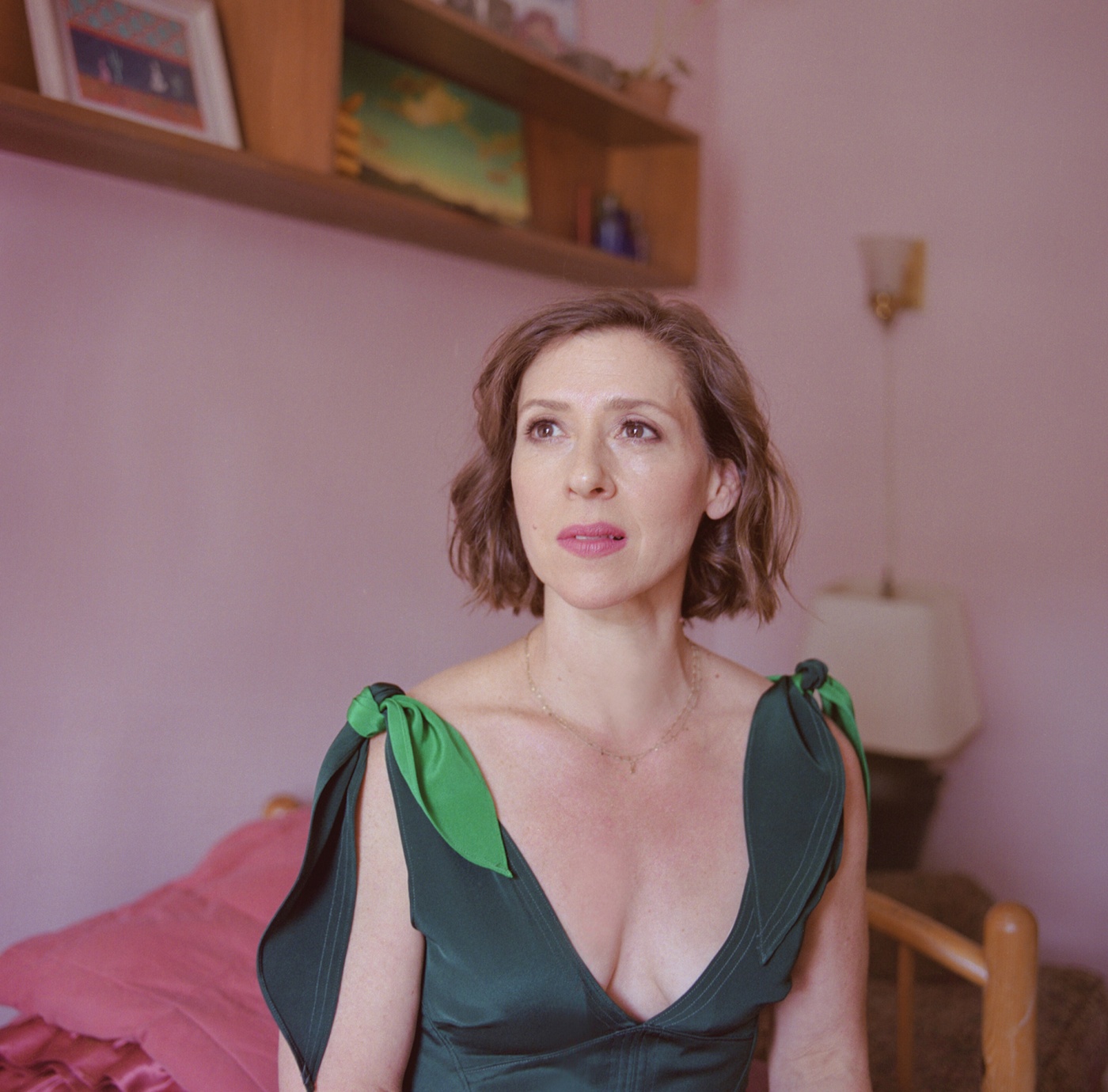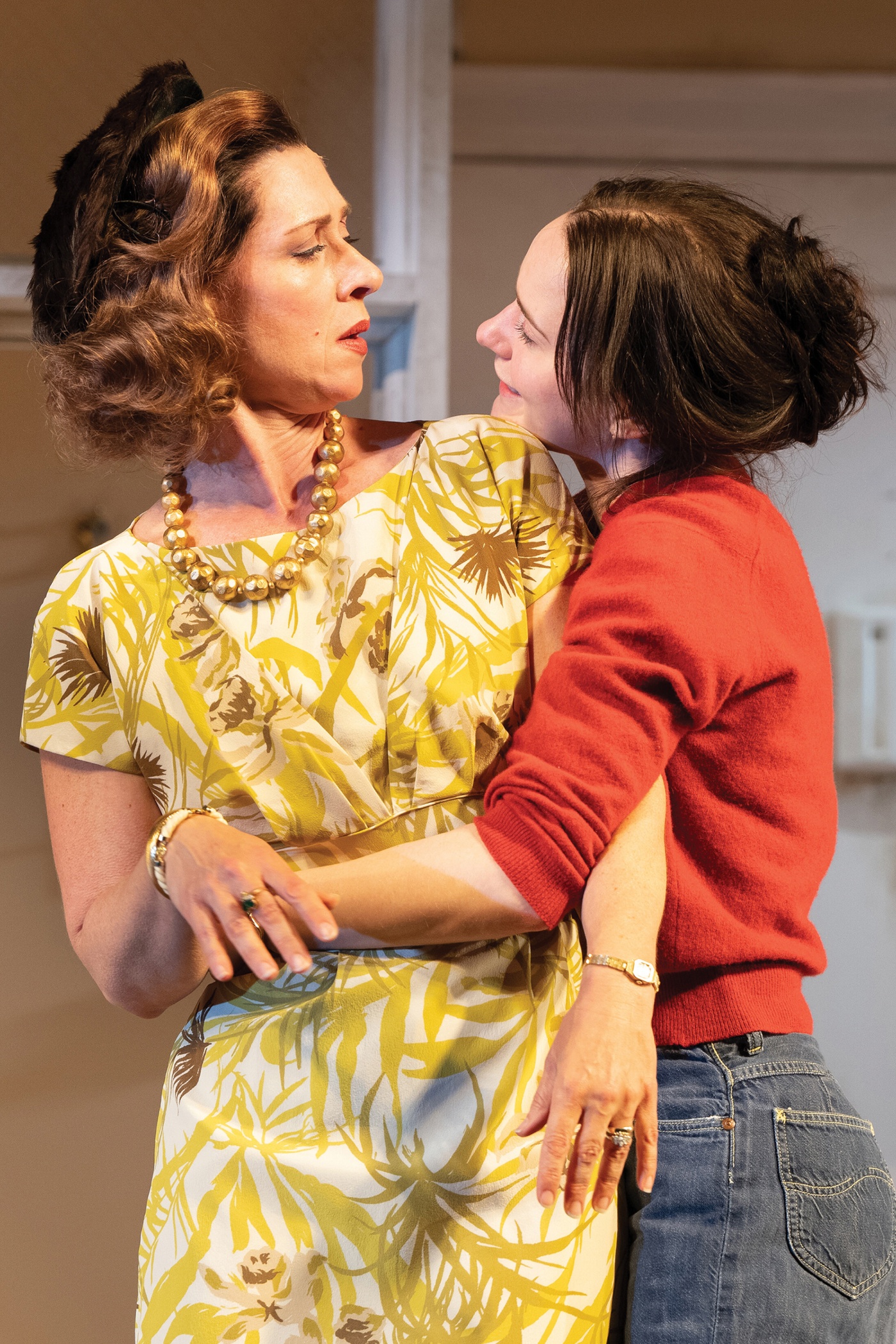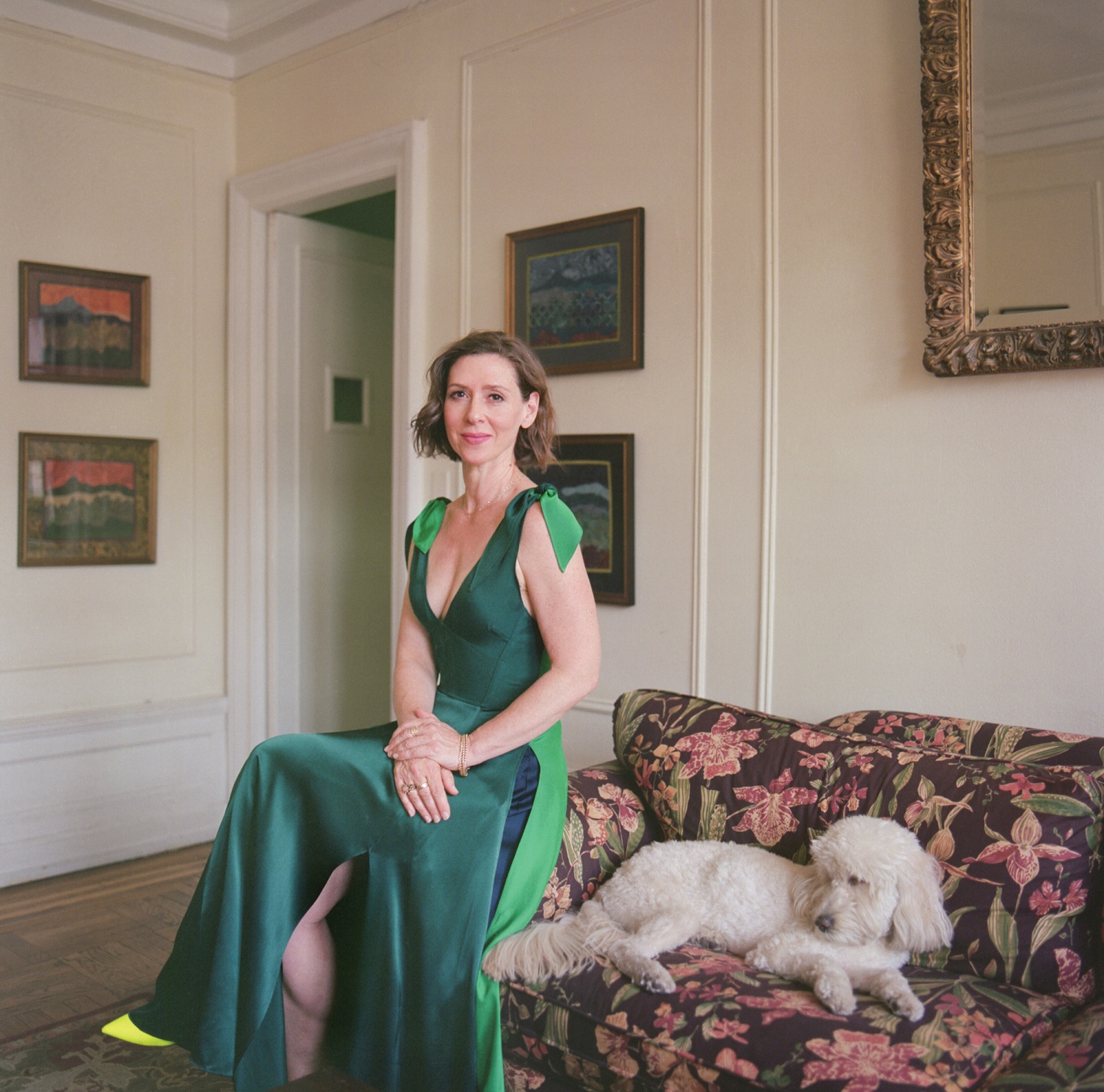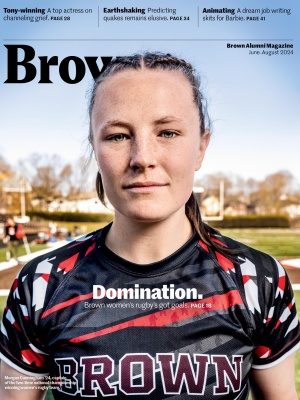Ovation
Miriam Silverman took her first Broadway bow the day after her mother died. A couple of months later, she took home a Tony.

She wasn’t used to the applause upon entering. As a professional stage actor for two decades, Miriam Silverman ’01, ’05 MFA, had come to expect applause at the end of the play. Then suddenly she was entering to an ovation, after winning a Tony last June for Best Featured Actress in a Play for her role in the Broadway revival of Lorraine Hansberry’s The Sign in Sidney Brustein’s Window. “It was thrilling,” says Miriam. “But like so much of this experience, it was complicated.”
On the eve of the show’s opening, her mom, Anita Silverman, had died. “I don’t subscribe to the ethos of ‘the show must go on at any cost,’” Miriam says. “Actors are people. But I was in pain all day long anyway. This at least gave me a chance to do something I loved each night.”
Anita had been one of her daughter’s biggest supporters. “When we did the first production in Chicago in 2016,” Miriam remembers, “my oldest had just turned two. My mom and dad basically came out to live with me for a month to help with childcare. I never would have been able to do it without them.”
Then early last year, The Sign in Sidney Brustein’s Window was scheduled for a remount at the Brooklyn Academy of Music, starring Oscar Isaac and Rachel Brosnahan. With that kind of star power, the chances of the show moving to Broadway were strong and Anita shared the excitement even as she was hospitalized with a respiratory illness. “I had a fitting around the time she went into the hospital and shared pictures of my revised costume,” Miriam says. “The whole experience held special memories for all of us, not just because I got to be a part of a brilliant play, but because of the moment it marked in our lives.”
As the remount began taking shape, things in the hospital took a turn for the worse. “My mom had to be put on a ventilator. My dad pulled me aside and said, ‘I know you, and if things go badly, you will feel like you should quit, but don’t. Your mom and I know how much this show means to you. She would want you to do it.’”
She fails with aplomb. She suffers with depth. She’s gorgeously imperfect, and it’s part of the reason she can embody such a wide range of roles.
A high-school Sophie’s Choice
Miriam always wanted to be an actor. But her path hasn’t always been straight or easy. Her first hard choice was back in 8th grade. She had been accepted into two highly selective New York public high schools: La Guardia—the performing arts school made famous in the movie Fame—and Bronx Science, one of the top academic schools in the city. Entering La Guardia meant committing the bulk of her energy and education to arts training. Meanwhile, Bronx Science had no theater program whatsoever. “It felt very much like choosing between two paths,” she said. “And I guess that is exactly what it was.” She chose Bronx Science.
At Brown she returned to theater with a vengeance. I met Miriam shortly after I arrived at Brown in January 1997 as a mid-year student. I knew I was going to be a theater major, and she was already “the one to watch” in the small but competitive department. Within weeks of arriving, she had auditioned and been cast in the faculty-directed mainstage production of Tom Stoppard’s Arcadia—a rare feat for a first-year student. It was all the more impressive considering it was to be her first full-length play. To most people, 18 years old doesn’t sound like a late start at anything, but for those of us who had grown up doing children’s theater on weekends and spending our summers in the dark rooms of theater camp, 18 seemed positively geriatric to be doing a full-length play for the first time.
After that first role, Miriam’s college career was up and running, and a few weeks after my arrival, so was our friendship. We did musicals together, took scene study, and even both got spots in the coveted Solo Performance class taught by then-faculty member Lowry Marshall.
But in a time of life when many of us were obsessed with dreams of stardom, Miriam was being led by a different north star. She was an East Asian Studies major at Brown, and when many of us went abroad to study Shakespeare, she took a year to live in Hong Kong and explore mainland China. Despite that, she moved effortlessly between student and faculty productions, straight plays and musicals, and even writing and acting. She enrolled in every theater class available (minus the technical classes required for the major). She was serious about it all, but she also knew how to have fun. We spent many late nights gossiping and dancing at her place on John Street. After graduation and a gap year, she took a chance and joined the inaugural class of the Brown/Trinity Rep Consortium.

“I wanted to perform, but I was also always so practical. I wanted to be a working actor,” she says. “When I was training and working with people who were actually doing it for a living, I broadened my understanding of what it meant to ‘do well’ in the industry. I wanted to have longevity in my career and also have a life.”
The long road to becoming an overnight sensation
While the graduate program at Brown/Trinity looked promising, it did not yet boast the reputation it has now. Joining the very first class came with a fair amount of risk. “I got out of graduate school with excellent training and almost no connections,” she says. “I was going to have to find my own way.”
She embarked on an impressive regional career, working at esteemed theaters such as the Guthrie, Arena Stage, and Shakespeare Theatre. “I had more offers for regional theater than I could ever do,” she remembers. She met and married fellow actor Adam Green (Harvard ’99), and together they even considered making the move permanently to D.C., where both of them were finding work consistently. But both she and Green are from New York. “Our families are here, and we knew we wanted kids,” she remembers. “But also, I did feel like I belonged in New York. I wanted to be part of the conversation that was happening here.”
Her first big break into that conversation came when she was cast in the Page 73 production of Clare Barron’s You Got Older in 2014. It was her first project with Anne Kauffman, a director with whom she would come to collaborate frequently, and who would go on to cast her in The Sign in Sidney Brustein’s Window. “That was a real turning point for me,” she says. “I felt like I had finally cracked into that New York new play world I really wanted to be a part of.”
On being Jewish and playing an antisemite
Miriam’s interest in social justice and identity as a Jewish artist has made the attention to her role in Sidney all the more interesting. Mavis, the uptight, wealthy, judgmental sister-in-law of the title character, is also a blatant racist and antisemite. She is also a compelling character, and Miriam mined her two major scenes to find dimension, depth, and some brilliant comedic moments. “I think there is something wonderful and subversive about it,” she says about her casting in the role. “A lot of directors would have written me off at face value, but (director) Anne (Kauffman) saw that I was the right actor for the role.”
At a time of life when many of us were obsessed with dreams of stardom, Miriam was being led by a different north star.
Throughout her career, Miriam has been drawn to characters who embody the innate contradictions that come with being a living, breathing human being. “I’m interested in all the oppositional forces of a character. I’m not drawn to playing a good person who’s suffering or a bad person with no redeeming qualities,” she says. “What tends to get me really excited is when a character can be passionate about their convictions, even if they still have a lot of change and growth ahead of them.”
Mavis is just such a character, and she tends to draw attention to actors who embody her. Both actresses who had played it previously were nominated for Tonys, and Alice Ghostley, who played Mavis in the original 1965 Broadway production, also won Best Featured Actress in a Play. Still, the play has long languished a bit in the shadow of Hansberry’s most famous and oft-produced work, A Raisin in the Sun.
“One of the reasons Sidney was so much fun to do was that it really felt like we were doing a new play in some ways,” Miriam says. “People didn’t know it. It was upending expectations.” Despite her early career work in Shakespeare, Ibsen, and other classics, Miriam’s heart and hunger lie in new writing and new play development. “There’s nothing like the gift of feeling an audience experiencing something for the first time,” she says. “I love doing Shakespeare, but I don’t necessarily need to watch another production of Measure for Measure to dive into conversations about gender and the patriarchy. There are a lot of playwrights working on new plays about that!”
Miriam credits the training she received at the Brown/Trinity Consortium with both her interest and skill in working on new plays. “I was there with Oskar (Eustis) and Paula (Vogel), and so much time was spent collaborating with the playwrights and workshopping their new material,” she remembers. In the last ten years, that experience and skill has landed her in rooms with some of America’s most exciting new playwrights, including Clare Barron, Will Arbery, Amy Herzog, Anna Ziegler, and fellow Brown alum Jen Silverman ’06, just to name a few.
“I am definitely drawn to plays that experiment with form—plays that are using language with a momentum and tautness,” she says. “I like it when there is a kind of illogic to work through. I want things to be hard, and I want it to be a challenge so I can grow through each project and sharpen new skills.” Miriam ties some of her interest in form and language back to her fascination with studying Mandarin in high school and college. “I loved the pictographic aspect of it; I loved how hard it was as a native English speaker to learn pronunciation. The history, etymology of the characters, culture… I was just in love,” she remembers. “But I think there was always a broader fascination with language and the way it gets used, which is true for many actors.”

According to Miriam, it is not only Shakespeare and Chekhov who use language in striking and complex ways. It’s one of the reasons she loves using new plays with her students. “So many contemporary playwrights are using language to do something complicated and challenging,” she says. “It might sound like just hyperrealism to an audience, but what does it mean for an actor when a character changes thought abruptly in the middle of a sentence, or just completely drops off mid-word? You have to fill the next moment, to create these maps in your brain of how the words connect.”
Always “right at the start of something”
Since our late teens at Brown to our current, mid-forties in New York, Miriam and I have continued to spend time together, from rehearsal rooms to book clubs. As friends, we commiserate as much as we celebrate: our weddings, my mom’s death, the birth of her children, the doldrums of lockdown.
I saw The Sign in Sidney Brustein’s Window just weeks after Anita died, and Miriam’s performance was captivating. I wasn’t surprised. It is not so much that Miriam makes success seem effortless; it’s that she’s open about embracing setbacks as part of the process. She fails with aplomb. She suffers with depth. She’s gorgeously imperfect, and it is part of the reason she can embody such a wide range of roles with such breathtaking humanity.
The application of her humanity is not limited to her work as an actor—she is an outspoken advocate for causes she cares about. A founding member of the Fair Wage on Stage movement, since winning the Tony she has been putting her newly elevated profile to good use, participating in the Covenant House Sleep Out to End Homelessness and Broadway Acts For Abortion Fundraiser. She was a frequent fixture on the picket lines for the SAG-AFTRA strike (her husband is an actor and organizer for the organization). But she is careful not to label herself an “activist.” Having grown up with two parents who were active in the Progressive Labor Party Movement and other causes, she witnessed the kind of time and commitment being an activist requires. “My whole life I watched two people who prioritize their values over money and notoriety,” she says. “I think that impacted me and my life goals. I knew I wanted to have interesting roles and work with good artists. And I was doing that, so I felt successful.”
Still, winning a Tony has opened doors, and she plans to take every opportunity to continue to grow. “Winning a Tony at 45…I feel young,” she says. “I always feel like I am right at the start of something.”
Alix Sobler ’01 is an award-winning playwright and theater artist based in NYC.





